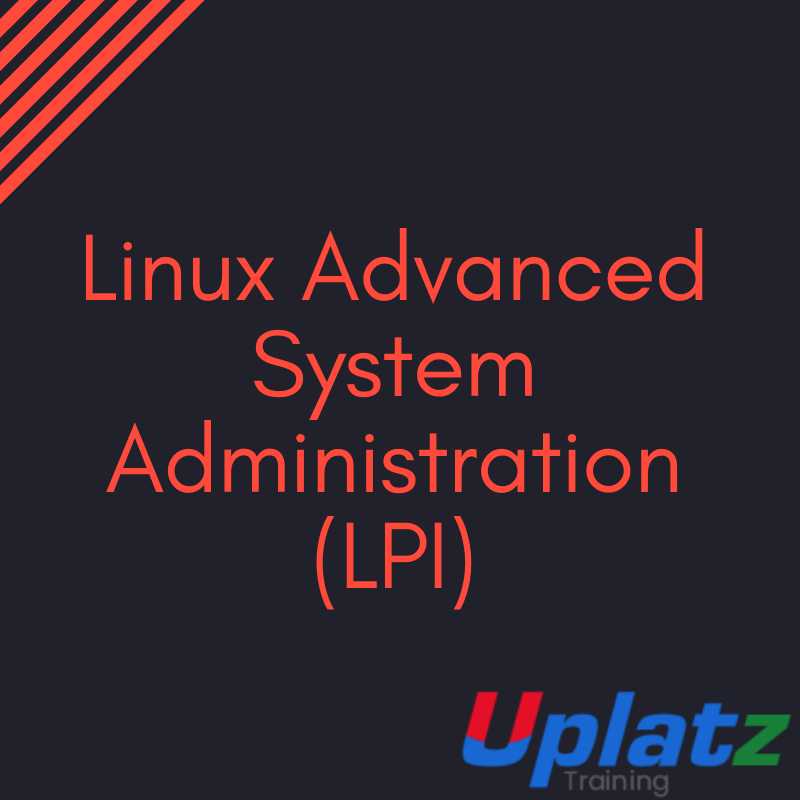Linux Advanced System Administration (LPI)

Linux Advanced System Administration (LPI) Course Overview
This instructor led Linux Advanced System Administration (LPI) training course is designed to teach the advanced administration, security, networking and performance tasks required on a Linux Enterprise system.
Targeted to closely follow the official LPI curriculum (generic Linux), this course together with the Linux System Administration course will enable the delegate to work towards achieving the LPIC-2 qualification.
Exercises and examples are used throughout the course to give practical hands-on experience with the techniques covered.
------------------------------------------------------------------------------------------------------------------------------------
Who will the Course Benefit?
The Linux Advanced System Administration (LPI) training course is suitable for Linux System Administrators who need to acquire advanced administration knowledge of the key administrative, networking and security tasks required on Linux within the Enterprise.
An ideal course for delegates who will be working in an environment using several different Linux distributions and therefore knowledge of skills common to all the different Linux distributions is required. For the purpose of practical exercises, SUSE Linux will be used.
Delegates who wish to work towards achieving the Linux Engineer LPIC-2 certification will find this course a good basis for LPIC-2: 201-450 and 202-450 exams.
The appendixes also include other related topics that would be useful reading for delegates preparing for certification.
Note: Should the delegate only require knowledge of Red Hat Linux then they should instead consider attending our range of Red Hat Linux Administration courses.
--------------------------------------------------------------------------------------------------------------------------------
Course Objectives
On completion of this course the delegate will have in-depth technical knowledge of what is required to administer Linux within the Enterprise. They will have gained practical experience of configuring administrative, networking and security aspects of a Linux Enterprise system to an advanced level.
The delegate will possess the essential knowledge required to work towards achieving the Linux Engineer LPIC-2 qualification.
------------------------------------------------------------------------------------------------------------------------------------
Course Description
Linux Advanced System Administration online course introduces management with administrative command-lines. Linux Advanced System Administration online course intention is to provide a practical experience of managing Cent OS 7 Linux servers.
Linux Advanced System Administration online course will allow the participants to learn more about Linux system administration.
Linux Advanced System Administration online course is ideally developed for system administrators who want to upgrade their knowledge in Linux.
In the Linux Advanced System Administration online training course, Uplatz provides an in-depth online training for the participants or learners to gain knowledge about Cent OS 7 server. Uplatz provides appropriate teaching and expertise training to equip the participants for implementing the learnt concepts in an enterprise.
Linux Advanced System Administration online training course curriculum covers CentOS 7, network configuration, CentOS 7 security.
With the help of Linux Advanced System Administration online course, the learners can:
-
Excel the Linux command line and its processes
-
Discover filesystems to check directory status and access modification times.
-
Form and manage user and group passwords securely.
-
Establish a web server, SSH, and DHCP, and use Netcat with Ping in a network.
-
Protect your server and configure SELinux (Security Enhanced Linux)
Uplatz provides an in-depth training to the learners to accelerate their knowledge and skill set required for a Linux System Administrator.
------------------------------------------------------------------------------------------------------------------------------------
This is a Linux Advanced System Administration (LPI) course by Uplatz.
Linux Advanced System Administration (LPI)
Linux Advanced System Administration (LPI) Training Course
Course Introduction
- Administration and Course Materials
- Course Structure and Agenda
- Delegate and Trainer Introductions
Session 1: ADVANCED NETWORK CONFIGURATION & TROUBLESHOOTING
- Configuring the network card (ip link, ip addr)
- Network scripts
- Configuring routing (ip route)
- Network troubleshooting and related tools (tcpdump, ping, mtr, traceroute, netstat, ss, arp, nmap, nc)
- Exercise
Session 2: APACHE, SQUID AND NGINX
- APACHE main configuration files
- APACHE server configuration (main Section entries)
- Starting APACHE
- APACHE access configuration
- Configuring secure APACHE (https)
- Configuring IP address-based virtual hosts
- Configuring name-based virtual hosts
- Configuring Apache for user-based content
- SQUID proxy server
- Configuring client browsers
- Starting SQUID
- SQUID configuration file (squid.conf)
- SQUID security settings
- NGINX Proxy and Reverse Proxy
- Exercise
Session 3: NFS NETWORK SERVICES
- NFS operation and daemons (portmapper etc.)
- Setting up an NFS server (/etc/exports and exportfs)
- Investigating the portmapper
- Setting up an NFS client (mount)
- Mounting NFS filesystems at boot (/etc/fstab)
- Using the automounter to access NFS mounts on demand
- Configuring AutoFS direct and indirect mounts
- Creating AutoFS units
- Exercise
Session 4: SAMBA
- SAMBA configuration file (smb.conf)
- Testing the SAMBA configuration (testparm)
- Configuring SAMBA users
- Mapping Windows and SAMBA users
- Starting SAMBA
- Managing Windows filesystems (smbmount, nmblookup)
- Accessing Windows shares
- Exercise
Linux Advanced System Administration (LPI) Training Course
Session 5: THE DOMAIN NAME SERVER
- DNS operation
- Types of DNS Servers
- Domain Name Space
- Setting up a DNS master and slave server
- Server configuration files (named.conf and databases)
- DNS resource record formats
- Configuring DNS logging
- Configuring DNS security
- Starting and managing the DNS Server (rcnamed, rndc)
- Testing the DNS Server (host, dig, nslookup)
- DNS Client set up (resolv.conf)
- Configuring DNS Clients
- Exercise
Session 6: DHCP
- Configuring DHCP
- The dhcpd.conf configuration file
- DNS entries
- Client address entries
- Address leases
- DHCP client configuration
- Exercise
Session 7: FTP
- Configuring a VSFTPD server
- Configuring FTP
- Configuring Pure-FTPd
- Configuring ProFTPd
- Active vs Passive mode
- vsftpd.conf configuration file
- Anonymous access
- Restricting access to the user's login directory
- FTP logfile
- Exercise
Session 8: CENTRALISED STORAGE WITH ISCSI
- Definition and benefits of iSCSI
- Configuring an iSCSI target
- Server target
- Client initiator
- Configuring the target an initiator with the yast tool
- Configuring the target an initiator with files and commands
- Configuring an iSCSI initiator
- Configuring iSCSI via YaST
- Exercise
Linux Advanced System Administration (LPI) Training Course
Session 9: ADVANCED FILESYSTEM TOOLS
- Converting Ext filesystems to Btrfs
- Checking and repairing Btrfs filesystems
- Creating Btrfs subvolumes and snapshots
- Labelling XFS filesystems
- Configuring UUIDs
- Performing full and incremental backups of XFS filesystems
- Querying the backup repository
- Restoring XFS filesystems
- Exercise
Session 10: LOGICAL VOLUME MANAGEMENT (LVM)
- LVM Overview
- Configuring LVM (pvcreate, vgcreate, vgextend, lvcreate etc.)
- Displaying information about the LVM environment (pvdisplay, pvs, vgdisplay, vgs, lvdisplay, lvs)
- Creating striped logical volumes
- Resizing Logical Volumes (lvextend, resize2fs, resize_reiserfs, xfs_growfs)
- Logical Volume Snapshots (lvcreate, lvdisplay)
- The Device Mapper
- Configuring the lvm.conf file
- Exercise
Session 11: RAID
- RAID overview
- Raw devices and partitions
- Creating a RAID device (fdisk, mdadm)
- Managing a RAID device (mdadm, /proc/mdstat)
- Creating and mount a file system on a RAID device
- Hot swapping failed drives
- Exercise
Session 12: DISK MONITORING WITH SMARTD
- Main features of monitoring disk devices with smartd
- Configuring smartd
- /etc/sysconfig/smartmontools
- /etc/smartd.conf
- Managing smartd with smartctl
- Exercise
Linux Advanced System Administration (LPI) Training Course
Session 13: LDAP
- Structure of an LDAP Tree
- Configuring the LDAP server (slapd.conf)
- Testing the LDAP server (ldapsearch)
- Adding information into LDAP (lpdapadd)
- Configuring the LDAP Clients (nsswitch.conf, ldap.conf)
- Testing the Client connection to the Server (getent)
- Exercise
Session 14: COMPILING SOFTWARE FROM SOURCE
- Installing programs from source (tar, tarball)
- Compiling Open Source Software (configure, make)
- Installing the compiled software (make install)
- Managing shared libraries (ldd)
- Compiling from SRC (source) RPM packages (rpmbuild, rpm)
- Exercise
Session 15: SYSTEM MONITORING & PERFORMANCE MANAGEMENT
- System performance monitoring
- Collecting system performance information (sar)
- Monitoring memory usage (free)
- Measuring virtual memory (vmstat)
- Measuring I/O performance (iostat)
- Performance Guidelines
- Exercise
Session 16: THE LINUX KERNEL
- Kernel naming conventions
- Monolithic and Modular kernel design
- Listing modules (lsmod, modinfo)
- Kernel module configuration
- Kernel tuning (/proc sysctl.conf, sysctl)
- Kernel compilation
- Exercise
Linux Advanced System Administration (LPI) Training Course
Session 17: FIREWALL CONFIGURATION
- Basic packets and routing
- Netfilter (iptables)
- Packet filtering (iptables, chains, rule targets, connection tracking)
- Saving and restoring firewall settings
- Network address translation (NAT)
- Exercise
Session 18: PLUGGABLE AUTHENTICATION MODULES (PAM)
- The main PAM configuration files (/etc/pam.d directory)
- Configuration file formats
- Controlling user access using the configuration files
- Configuring pam_listfile
- Controlling time-based access with PAM
- Controlling limits with PAM
- Exercise
Session 19: APPARMOR
- Enabling and disabling AppArmor
- AppArmor monitoring tools
- Building and modifying AppArmor profiles
- Logging AppArmor
- AppArmor Options
- Exercise
Session 20: SELINUX
- Installation and configuration of SELinux
- Installation of an SELinux policy
- Modifying an SElinux policy
- Modifying services within SELinux
- Exercise
Session 21: HARDWARE CONFIGURATION
- The Hotplug system
- Devices and Interfaces
- sysfs filesystem and persistent names
- Device initialisation and interface configuration
- Hotplug and Coldplug
- UDEV system
- Exercise
Addendum: Reference Materials (provided within the course handbook for additional reading)
APPENDIX A - CONFIGURING APACHE FOR PHP AND TOMCAT
- Configuring Apache Web Server to support PHP and Tomcat
APPENDIX B - BASIC OPENVPN
- Accessing a private network with OpenVPN
APPENDIX C - RAIDTOOLS
- Old style raidtools package
APPENDIX D - CUSTOM KERNEL CONFIGURATION
- Modifying the kernel configuration
- Installing kernel sources
- Configuring the kernel
APPENDIX E - DRACUT
- Managing the Linux boot process with dracut
APPENDIX F - ELECTRONIC MAIL AND POSTFIX
- A description of UEFI
- The UEFI partition
- Secure Boot
- UEFI operation
- The UEFI Shell
APPENDIX G - ELECTRONIC MAIL AND POSTFIX
- Basic mail server configuration with postfix
Attending this course will help the delegate gain many of the skills and product knowledge requirements as outlined in the exam objectives. Studying this course and its associated reference materials can form part of the preparation to achieve certification. Experience, practice, self-study and aptitude are also key requirements for exam success.
Before taking any exam, ensure you have the recommended experience. The LPI website lists all exam requirements and these are updated regularly.
Exams are not included as part of the course.
---------------------------------------------------------------------------------------------------------------------------
Linux Advanced System Administration online certification course with the help of expert professionals training is recognized across the globe. Because of the increased adoption of the Linux system administration in various companies the participants are able to find the job opportunity easily. The leading companies hire Linux System Administrator considering their skill of managing the operation of computer system. Linux Advanced System Administration online certification course is known for their knowledge in managing Linux operating system. After pursuing Linux Advanced System Administration online certification course the participants can become as a Linux administrator, Linux server administrator, Linux developer and can pursue a wide range of career paths.
------------------------------------------------------------------------------------------------------------------------------------








